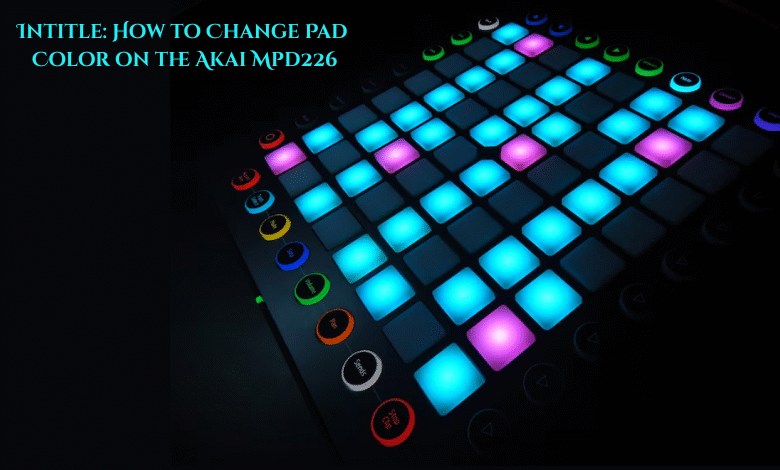Intitle: How to Change Pad Color on the Akai Mpd226

If you’re a musician, producer, or beatmaker, you’ve likely heard of the Akai MPD226 a MIDI pad controller that brings the tactile joy of drumming into your digital workflow. With its 16 RGB-lit pads, this device isn’t just about functionality; it’s about creativity and personalization too. One of the coolest features? You can change the pad colors to suit your style or streamline your music-making process. Whether you’re new to the MPD226 or a seasoned user looking to tweak your setup, this guide will walk you through everything you need to know about customizing those vibrant pads.
In this article, we’ll dive deep into why you might want to change the pad colors, what you’ll need to get started, and two detailed methods to do it one using software and another right on the device itself. Plus, we’ll share tips on organizing your workflow, compare the MPD226 to other controllers, and answer common questions in a handy FAQ section. Ready to make your MPD226 truly yours? Let’s get started!
What is the Akai MPD226?
The Akai MPD226 is a compact yet powerful MIDI controller designed to bridge the gap between hardware and software in music production. Part of Akai’s MPD2 series, it builds on the legacy of the iconic MPC line, offering modern features for today’s producers. Here’s a quick rundown of what makes it special:
-
16 RGB Pads: Velocity- and pressure-sensitive, these pads light up in various colors and are perfect for triggering drums, samples, or melodies.
-
Extra Controls: Four faders, knobs, and buttons, all assignable for hands-on control of your software.
-
MPC Features: Note Repeat, Swing, and Full Level bring that classic MPC feel to your beats.
-
Connectivity: USB-powered with MIDI In/Out ports and iOS compatibility (via a Camera Connection Kit).
-
Software Bundle: Comes with MPC Beats, Ableton Live Lite, and other production tools to get you started.
The RGB pads are the star of the show here. Unlike basic LED pads that might only glow red or green, these RGB lights can display a spectrum of colors red, blue, green, purple, you name it. Changing their colors isn’t just a gimmick; it’s a practical way to enhance your experience, whether you’re jamming in the studio or performing live.
Why Change the Pad Colors on Your Akai MPD226?
You might be wondering, “Why bother changing the colors?” Well, it’s more than just making your controller look pretty (though that’s a nice bonus). Here are some compelling reasons:
-
Organize Your Workflow: Assign colors to different sounds like red for kicks, blue for snares, or green for hi-hats—so you can find what you need at a glance.
-
Boost Creativity: Colors can inspire you. A warm orange might spark an energetic beat, while a cool purple sets the mood for something mellow.
-
Improve Visibility: In dim lighting, like a stage or late-night studio session, bright or contrasting colors make it easier to hit the right pad.
-
Personalize Your Setup: Match the pads to your aesthetic, your room’s vibe, or even your latest project’s theme.
-
Separate Pad Banks: With four banks of 16 pads each (64 total), unique color schemes can help you instantly know which bank you’re using.
Customizing your MPD226’s pad colors can transform it from a generic tool into an extension of your creative personality. Whether you’re a live performer or a bedroom producer, this tweak can make a big difference.
What You’ll Need to Get Started
Before we jump into the how-to, let’s make sure you’ve got everything ready. Here’s what you’ll need:
-
Akai MPD226: The star of this guide make sure it’s charged or connected.
-
USB Cable: This comes with your MPD226 for connecting to your computer.
-
Computer: For the software method, you’ll need a Mac or Windows machine.
-
Akai Software Preset Editor: Download this free tool from Akai’s website to customize your MPD226 via your computer.
-
Optional: If you’re skipping the software, just the MPD226 itself will do for on-device editing.
You don’t need to be a tech wizard to do this just a basic setup and a bit of curiosity. Oh, and if you’re new to MIDI controllers, here’s a quick primer: MIDI is a way for devices like the MPD226 to talk to your computer or synth, sending commands like “play this note” or “trigger that sample.” The MPD226 uses MIDI to control your music software, and its pad colors are part of that customization.
How to Change Pad Colors Using Software: Step-by-Step
The most detailed way to change your MPD226’s pad colors is through the Software Preset Editor. It’s user-friendly and gives you full control over each pad. Here’s how to do it:
-
Download and Install the Software
Head to the Akai Professional website, find the MPD226 product page, and download the Software Preset Editor. Install it by following the on-screen prompts pretty straightforward stuff. -
Connect Your MPD226
Plug your MPD226 into your computer using the USB cable. Make sure it powers on (the pads might light up in their default colors). -
Launch the Software
Open the Software Preset Editor. You’ll see a virtual layout of your MPD226, with the 16 pads, knobs, and faders displayed. -
Pick a Preset
The MPD226 has 30 preset slots for different setups. You can tweak an existing one or start fresh by selecting “New Preset” (or similar check your software’s options). -
Select a Pad
Click on one of the 16 pads in the software. A settings panel should pop up on the side or below it. -
Change the Color
Look for a “Color” option it might be a dropdown list (e.g., Red, Blue, Green) or a color picker where you can choose custom shades. Pick the color you want for that pad. -
Repeat for Other Pads
Go through each pad you want to customize, assigning colors as you see fit. Maybe red for drums, yellow for effects whatever works for you. -
Save Your Preset
Once you’re happy with the colors, hit “Save” in the software. Give your preset a name like “My Beats” or “Live Set.” -
Send It to the MPD226
Click a button like “Send to Device” or “Upload Preset” (the exact wording depends on the software version). This transfers your settings to the controller. -
Test It Out
Unplug the MPD226 and turn it on. The pads should glow with your chosen colors. If they don’t, double-check the connection or reload the preset.
This method is great because it’s visual you see exactly what you’re changing and you can save multiple presets for different projects or gigs.
How to Change Pad Colors On the MPD226 Itself
Don’t have a computer handy? No problem! The MPD226 lets you tweak pad colors right on the device using its edit mode. Here’s the process:
-
Enter Edit Mode
Press the “Edit” button on the MPD226 (check your manual for its exact location it’s usually near the display). The LCD screen should show you’re in edit mode. -
Hit a Pad
Tap the pad you want to change. The screen will display something like “Pad 1” along with its current settings. -
Find the Color Setting
Use the arrow buttons (left/right or up/down) to scroll through the pad’s parameters until you see “Color” or something similar. -
Pick a Color
Turn the rotary knob (a small dial on the MPD226) to cycle through available colors think red, green, blue, maybe purple or yellow. Stop when you find the one you like. -
Save the Change
Press “Enter” (or a confirm button) to lock in the new color for that pad. -
Repeat as Needed
Go through steps 2-5 for each pad you want to tweak. -
Exit Edit Mode
Hit the “Edit” button again to get back to normal mode. Your pads should now show their new colors.
This method is quick and portable no computer required. The downside? It might offer fewer color options than the software, and it’s less visual since you’re relying on the small LCD. Still, it’s perfect for on-the-fly adjustments.
Tips for Customizing Your Pad Colors
Now that you know how to change the colors, let’s talk about making them work for you. Here are some ideas to get the most out of your MPD226:
Color-Code Your Sounds
Assigning colors to sound types can speed up your workflow. Here’s a sample setup:
|
Sound Type |
Color |
Why It Works |
|---|---|---|
|
Kick Drum |
Red |
Bold and foundational |
|
Snare |
Blue |
Stands out from the kick |
|
Hi-Hat |
Yellow |
Bright and crisp |
|
Percussion |
Green |
Earthy and versatile |
|
Bass |
Purple |
Deep and rich |
|
Synth/Melody |
Orange |
Warm and melodic |
|
Effects |
Pink |
Fun and attention-grabbing |
Feel free to tweak this based on your style maybe cyan for vocals or white for transitions.
Organize by Bank
The MPD226 has four banks (A, B, C, D), giving you 64 pads total. To keep them straight:
-
Bank A: All red tones for drums.
-
Bank B: Blues for melodic elements.
-
Bank C: Greens for effects.
-
Bank D: Mixed colors for miscellaneous sounds.
This way, a quick glance tells you where you are, especially during a live set.
Match Your Vibe
Pick colors that reflect your music or mood. Working on a chill track? Go with soft blues and purples. Hyping up a crowd? Bright reds and yellows. It’s like setting the stage visually before you even play a note.
Think About Lighting
If you’re in a dark studio or on stage, test your colors in that environment. Bright shades like white or neon green pop better than muted ones like brown or gray.
Save Multiple Presets
The software lets you store different color setups. Create one for studio work, another for live gigs, or even one per genre trap could be dark purples and blacks, while house might be vibrant pinks and oranges.
How Does the MPD226 Compare to Other Controllers?
Wondering how the MPD226 stacks up against other pad controllers? Here’s a quick comparison focusing on pad customization:
|
Feature |
Akai MPD226 |
Novation Launchpad |
Ableton Push |
|---|---|---|---|
|
Number of Pads |
16 (64 w/ banks) |
64 | 64 |
|
RGB Pads |
Yes |
Yes |
Yes |
|
Per-Pad Customization |
Yes |
Yes |
Yes |
|
On-Device Editing |
Yes |
No |
Yes |
|
Software Needed? |
Optional |
Yes |
Optional |
The MPD226 shines with its on-device editing a rarity among controllers and its compact size. The Launchpad offers more pads but relies on software, while the Push is a powerhouse with deeper integration (at a higher price). For color tweaking, all three deliver, but the MPD226’s flexibility makes it a sweet spot for many.
Troubleshooting Pad Color Issues
Sometimes things don’t go as planned. Here’s how to fix common hiccups:
-
Colors Don’t Change: Ensure you saved and sent the preset in the software, or double-check you hit “Enter” in edit mode. Restart the MPD226 if needed.
-
Software Won’t Connect: Check your USB cable and port. Reinstall the Software Preset Editor if it’s glitchy.
-
Limited Colors On-Device: The hardware might offer fewer options than the software switch to the editor for more variety.
-
Pads Reset: If colors revert after unplugging, make sure the preset is saved to the device, not just the software.
If all else fails, Akai’s support or the user manual can dig deeper.
Going Beyond Static Colors
Want your pads to dance with your music? Some setups let pad colors change dynamically like glowing brighter with harder hits or switching when a loop plays. This requires your DAW (like Ableton or FL Studio) to send MIDI feedback to the MPD226, which isn’t a basic feature. It’s advanced stuff, but if you’re curious, look into your software’s MIDI mapping options. For most, static colors are plenty to start with.
Why the Akai MPD226 Stands Out
Beyond pad colors, the MPD226 is a solid pick for producers. It’s portable (USB-powered, no bulky adapter), durable (built for gigging), and packed with extras like faders and knobs. The included software MPC Beats and Ableton Live Lite means you can start making music right away. Add in the color customization, and it’s a tool that grows with you, from beginner beats to pro-level performances.
Wrapping It Up
Changing the pad colors on your Akai MPD226 is a simple tweak with big rewards. Whether you use the Software Preset Editor for precision or the on-device method for speed, you can turn those 16 pads into a personalized command center. Color-code your kicks and snares, set a vibe for your next track, or just make it look cool the choice is yours.
Experiment with different setups, save your favorites, and watch how a little color can transform your workflow. Got questions? Check the FAQ below or hit up Akai’s resources. Now, go light up your beats!
FAQ: Your Pad Color Questions Answered
How do I change the pad colors on my Akai MPD226 without a computer?
Press the “Edit” button, tap a pad, scroll to the color option with the arrows, pick a color with the knob, and hit “Enter.” Repeat for each pad, then exit edit mode.
What colors can I use on the Akai MPD226 pads?
The RGB pads support tons of colors red, blue, green, purple, yellow, and more. The software might offer custom mixes, while on-device options could be preset shades.
Will changing pad colors mess with my sounds?
Nope! The colors are just visual they don’t affect what the pads trigger or how they sound.
Can the pad colors sync with my music on the MPD226?
Not out of the box, but with MIDI feedback from your DAW, you could set it up to change colors dynamically. It’s a bit complex check your software’s manual.
How do I reset my MPD226 pad colors to default?
In the software, load a default preset or reset it via the device’s global settings (see the manual for the exact steps).



